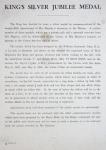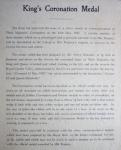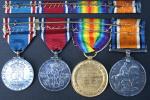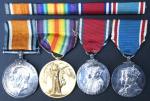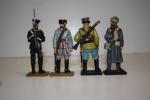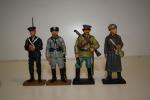-
Posts
13,225 -
Joined
-
Last visited
-
Days Won
22
Content Type
Profiles
Forums
Blogs
Gallery
Events
Store
Everything posted by Mervyn Mitton
-
Dan - thankyou very much for all of that information. I found it fascinating reading - however, although it shows ranks - it makes no mention of a Fascist High Leader. He must have been a political official ? Perhaps someone may know ?
-
Hi - Kano. Welcome to GMIC - I am sorry no-one has answered your question. Sometimes it is very hard to tell from a photograph. Looking at them I must say that I have a few doubts - nothing definite, just a feeling. They are turning bars out today as some 'collectors' like to add them to their groups. Using them to replace a missing one shouldn't present any problems.
-
-
-
-
I have recently bought a collection of 17 bayonets - some rare ones amongst them. I will gradually post the more interesting ones and perhaps members will add details. However, this morning , quite out of the blue , I bought an Italian dress dagger - and this turns out to have belonged to quite a high official. Mussolini had great admiration for Hitler and his Third Reich and attempted to copy them in many aspects of equipment and uniform. Ornamental dress daggers for different groups and ranks were adopted and this example turns out to be a MVSN (not sure what this stands for ?) for a Fascist High Leader. I am assuming that this a high party official - possibly in charge of an area ? The refs. show that they mainly had white handles - however, more rarely black handles - as here - were used. The Fasces - or, the old Roman symbol for a Magistrate, the rods meaning that he could order a flogging - and the axe, death - were adopted by the Fascisti and are present on the handle in brass. The black scabbard has a copper base section and brass bands for the suspension rings. The dagger is 13 .5 " overall (33cms) - the pommel and grip are 4.5" (11cm) and the chromed blade is 8" (20cm). There are no makers marks - which seems to be the norm. These Italian daggers are far fewer then the German ones - although usually less in price. I look forward to any comments.
-
Thank you for comments. Brett - I would not dispute your figures - it takes only one dedicated person to get things moving. I am in fact surprised at how quickly most police forces adopted - what to them - was a strange set of equipment. The Metropolitan adoption of a dedicated Fingerprints Department was the catalyst that brought them into general use.
-
There are many aspects of policing that are taken for granted - or, overlooked. For the past 111 years fingerprints and the science of reading their patterns have formed an important part in the science of detecting crimes. Without fingerprints in today's world it is doubtful if we could still control the steady rise in crime. The man credited with discovering that fingerprints are unique to the person and that they remained throughout life, is Sir William Herschel. He was an Administrator in the Indian State of Bengal and spent time looking into the characteristics of our skin. He realised that this would be an ideal way to track criminals, as it was difficult not to leave an impression on whatever you touched. He was not the first to notice the prints - there are writings going back to Roman times - however, he was the first to link them to the person. Towards the end of the 19th Century two scientists - working separately - Sir Francis Galton and Henry Faulds, worked out a method of how to classify and research them. This led to a Royal Commission in 1900 - appointed by the Home Secretary - to investigate a possible use for them. This was led by Sir Edward Henry - later to become the Commissioner at Scotland Yard. This led directly to the setting-up of a Fingerprints Branch at Scotland Yard - HQ of the Metropolitan Police - in July 1900. Sir Edward Henry had also worked out a classification system and this was the one chosen. The Department now numbers over 600 people - against the original 3 ! Many of us on this Forum are serving , or , exPolice Officers and know how important they are in the solving of crimes. Probably an even more important purpose for them is the ability it gives the Police to find out the antecedants (past record) of a criminal and to be able to tell the Courts of any past crimes. When I was still in uniform you had to take your prisoner's fingerprints once he had been charged. A dirty job, it involved a brass plate - mounted on a block of wood - a roller, a tube of ink and a special fingerprint form. This had designated spaces for each hand and each finger and thumb. You inked the plate - rolled his digit - and then transferred it to the right place on the form. When you'd finished you had to clean the mess. I expect today they are more organised with digital recording - perhaps someone could tell us how it is done today - I'm going back 37 years ! This fingerprint kit is a very early and very rare pattern - probably the first issued on Division. I have no idea of who was responsible for using it - or, what they did with 'lifting' the prints. I have looked through many ref. books - but, it is a neglected subject. I lent this to an exhibition some years ago - hence the label - however, I think it was given out early in the 1900's. I was given it by an old gardener at the house who had been a Sgt.in F Div. - he found it at the back in the stores - long forgotten.
-
It has just been announced that the South African Police are currently being investigated for 6000 official complaints against them. 2400 are for crime. Even in Africa, this seems a little excessive on their part.............
-

Gordon F.S. helmet hackle
Mervyn Mitton replied to jf42's topic in Great Britain: Militaria: Badges, Uniforms & Equipment
Toby - with your long military career you know - as do I - that a personal approach is always better. You have IM'd me and I am pleased to hear from you and also to see you posting. We do not want to lose you as a member - especially not over a small matter . Please continue to post and do tell us about your background - your knowledge and expertise will be valued. Mervyn -
Brett - there must have been a record for those given the awards. However, were the recommendations from the S.A. Govt. - or, did the Governor's office draw up a list ? Never thought about it before. I was pleased to see the instruction sheets - they never stay with the awards. I like your new Avatar - NMP - Natal Mounted Police. Only three genuine ones are known - I would say a post should be coming-up from you about their history ? Mervyn
-
I thought these very interesting - and such an early date for the Communist Regime . However, I have a question - the stamped lettering is in English. Was this done at the time to earn Foreign exchange - or, have they been boxed at a later time in the UK or, US ?
-
This is an attractive and interesting group - originating in the First World War with War and Victory medals. He was later awarded the 1935 King George 5th. silver Jubilee Medal (25 years) and this was followed with the 1937 Coronation Medal for King George 6th. This is a fairly unusual extra awarding for someone who was only a Private. I understand that he became South Africa's first land surveyor to be educated in this Country. He was ; Pte. M.A.Cross. 6th SAI - this was the 6th South African Infantry and was made up from Natal, Orange Free State and Eastern Province Regiments. The Victory Medal is the S.A. Bi-lingual version (English & Afrikaans). His ribbon bar is also present. Unusually, he kept the printed sheets which came with the Jubilee and Coronation and mounted them for display. They make interesting research reading.
-
-
-
-
-









